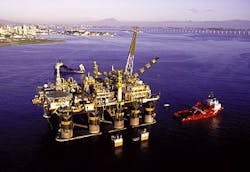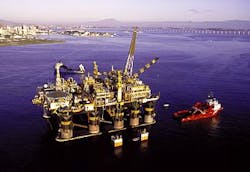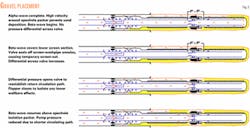Cross-discipline technologies such as downhole intelligent components combined with multizone sand-control systems in long horizontal laterals will improve reserve recovery, eliminate unnecessary well intervention, and meet operational safety requirements for some deepwater completions off Brazil.
For instance, a well in Brazil's deepwater Campos basin will soon have the world's first subsea fully electric intelligent system.
This completion will also mark the first integration of an all-electric, remotely operated intelligent well system for managing an injection well in a gravel-packed wellbore.
The completion will integrate Baker Oil Tools' InCharge intelligent well system with specialized openhole gravel-packing processes and technologies that have been successfully applied in 21 subsea wells globally and 7 subsea wells in the Campos basin.
The openhole gravel packing with zonal isolation packers had its first deepwater application in Well Marlim 7-MRL-126HP-RJS. (OGJ, Nov. 12, 2001, pp. 53-58).
To validate the reliability of the all-electric intelligent well system before deployment in a subsea deepwater environment, Petroleo Brasileiro SA (Petrobras) and Baker Oil Tools jointly developed a testing and qualification program for live-well functional compliance in a land-based, cased-hole completion in the Mossoró field. (OGJ, Oct. 22, 2001, p. 52).
Economic drivers
Exploitation of Brazil's deepwater reserves depends on processes and technologies by which the reserves can be extracted safely yet economically. Petrobras has adopted such technologies as Level 5 multilateral wells and multilobe subsea horizontal gravel packs with zonal isolation.
Two of the most prolific fields in the Campos basin, Marlim and Roncador, have sandstone reservoirs without a significant natural water drive; therefore these fields need water injection for pressure maintenance and effective sweep efficiency.
These unconsolidated reservoirs also require sand control for both producers and injectors.
The deep waters off Brazil have more than 95 subsea horizontal gravel packs in both production and injection wells. Some of the more recent completions include zonal isolation in conjuction with horizontal gravel packs that include diverter valves.
These completions allow Petrobras selectively to drain reservoir zones and shut-off water-producing zones.
Integrating technology
Petrobras knows that integrating intelligent well technology into multilateral and sand control systems holds the potential to extend and expand the basic well production life and improve reservoir management.
Before implementing this technology in this high-cost environment, Petrobras addressed the historical operational reliability concerns related to hydraulically operated downhole flow control devices and determined the value of additional downhole sensors with which to resolve key uncertainties critical to deepwater production and reservoir management.
Factors contributing to its selection of an all-electric intelligent well system for the Campos basin included:
•Subsea well intervention costs of about $3-5 million/occurrence.
•Reservoir and production management benefits from discrete pressure and flow measurements for each zone.
•Acquisition of data from each zone instead of running and positioning single, permanent, downhole, quartz-transducer, and pressure and temperature gauges above the production packer.
•The limited number of penetrations in the subsea trees and tubing hangers for the deepwater Campos basin. These wells have three penetrations: one for downhole gauge electrical line and two for the hydraulic lines controlling the subsurface safety valve.
Base requirements
Petrobras preferred the intelligent well system to operate within its existing standardized design and without requiring additional significant costs to wellheads or downhole equipment. The base requirements included:
- Ultradeepwater completions in 1,850-2,000+ m of water.
- Deviated and horizontal injection and production wells with sand control.
- 95/8-in. production casing and 51/2-in. 13 chrome tubing.
- Cased and perforated 7-in. completion liners.
- Two and three-zone frac-packed completion intervals.
- Selective, infinitely variable, choke-type, zonal flow control.
- Continuous downhole monitoring of pressure and temperature, in both tubing and annulus (sandface) in both zones.
- Continuous downhole monitoring of mass flow to and from each zone.
- Compatibility with present seabed tree, control, and umbilical systems.
- Compliance with all established ultradeepwater safety, operational, and testing procedures.
Merging the technical and functional parameters defined by Petrobras resulted in an intelligent well system designed to monitor and control multiple production or injection intervals within a one-trip, single string, selective completion (Fig. 1).
Openhole gravel packs
Gravel-packing openhole completions in oil and gas wells is a globally applied technique to control formation sand production. One must effectively implement each component of the openhole completion process to maximize well productivity and provide sand control for the entire life of a well.
During installation of an openhole gravel-pack installation, one places a screen in the well across the productive interval and then circulates highly permeable gravel or proppant, mixed in a carrier fluid, into the well to fill the annular space between the screen and formation.
Specialized downhole tools facilitate wellbore stability and circulation of the gravel-pack sand. The tools create a circulating path for the gravel slurry to flow down the workstring into the annulus below a packer and outside the screen.
The screen retains the gravel, and the carrier fluid flows up the washpipe and out into the annulus above the packer to surface. A complete gravel pack in the open hole to screen annulus creates a very stable, long-lasting downhole environment in which only well fluids, not formation sand, are produced.
Although the industry uses both low and high-viscosity carrier fluids for gravel packing, studies show that low-viscosity carrier fluids are more effective in achieving void-free openhole gravel packs. The pressure-control concept discussed in this article and applied by Petrobras in the Campos basin is applicable only when low-viscosity carrier fluids are used.
Gravel packing with low-viscosity carrier fluid relies on high fluid velocity to transport the gravel-pack sand. When well deviation exceeds 60°, the gravel-deposition pattern changes so that the low side of the well is packed first followed by the high side. Intensive studies based on more than 400 successful horizontal gravel-pack installations over a 12-year period reveal that this type of deposition has a predictable, two-stage Alpha and Beta-wave pattern.
In the first stage, one pumps the gravel-pack slurry down the workstring until it enters the large flow area in the annulus beneath the packer. In this larger flow area, the slurry velocity decreases and gravel begins to settle on the low side of the wellbore.
The settling gravel begins to form a dune that grows in height. As it does so, the available flow area decreases and slurry velocity increases. Very quickly, an equilibrium condition develops in which the slurry velocity above the dune is sufficient to erode the top of the dune and prevent further height growth. At this point, the dune begins to propagate down the length of the well in what is commonly referred to as the Alpha wave.
The Alpha wave continues to propagate down the well until it reaches the end of the screen or the end of the washpipe (whichever comes first), where the carrier fluid enters the screen and is circulated out of the well. At this point, the second (Beta wave) stage of the high-angle gravel deposition process begins.
During this stage, the gravel-pack sand fills the annular area remaining above the gravel deposited during the Alpha wave.
The Beta wave propagates from the toe of the well up to the heel.
As gravel fills the annular area outside the screen, the carrier fluid diverts into the restricted area of the screen-washpipe annulus and is circulated out of the well.
As the Beta wave continues to move toward the heel of the well, the distance of flow in the screen-washpipe annulus gradually increases, resulting in a steady increase in the surface pumping pressure.
When gravel covers the top section of screen, the process experiences a very sharp increase in pump pressure, indicating that the gravel placement is complete.
Diverter valves
Historically, a positive mechanical barrier in the open hole was not possible because of the Beta-wave placement of gravel to fill the complete wellbore.
Because in this process gravel fills both the screen and packing element annuli, the gravel prevents setting or inflating a positive sealing element in the open hole.
The seal element is required when incorporating multizone intelligent well inflow control devices.
To solve this problem, Baker Oil Tools developed a differential pressure-actuated washpipe diverter valve known as Beta Breaker that can be run in the inner washpipe to actuate and redirect return fluid flow and thus create a gravel-free annulus around an openhole isolation packer.
With the annular space open, inflation or actuation of an openhole packer can provide the positive mechanical barrier for isolation that is required for incorporating multizone intelligent well inflow control devices (Fig. 2).
The diverter valve eliminates the need for the gravel-pack carrier fluid to travel the length of the screen for a return path entry into the washpipe. One initiates valve actuation during placement of the Beta wave by differential pressure across a sealed area between the washpipe and screen assembly.
Field-proven computational models allow the effective design and placement of the valves within the gravel-packing assembly.
This technology essentially eliminates the Beta-wave pressure as a limiting factor when gravel packing extended lateral completions and allows setting of the isolation packers in openhole.
Operators have installed these valves both in Brazil's Campos basin and the North Sea.
Diverter valves off Brazil
Petrobras has completed seven wells in the Campos basin with diverter valve technology or diverter valves with openhole external casing packers (ECPs) to establish mechanical isolation in openhole gravel packs.
The first well with diverter valves and ECPs was 7-MRL-126HP-RJS, a subsea oil well in 3,221 ft of water. The well produces from an unconsolidated sandstone with two lobes separated by shale (Table 1).
The completion objectives for this well were to establish sand-control gravel-pack integrity, isolate the shale interval, and provide a barrier for future water shutoff in the lower lobe of the lateral section.
The well was completed from a floating vessel, and required openhole stability during all phases of the completion process.
To achieve this stability, the procedure requires keeping a pressure balance openhole gravel-pack system with a weight set-down system for all tool positions to account for any rig movement.
The first step in the job included generation of a computational model for determining the circulation rate. Next was the selection of the ECP OD so that the critical velocity for solids transport would be exceeded to prevent deposition of gravel around the ECP during Alpha-wave placement.
In the next step, the job involved circulating fluid to clean the open hole and leave brine in the open hole before running the openhole gravel-pack assembly. The drill-in fluid was then displaced from the casing and riser.
The shale section, from 11,549 to 11,667 ft, affected the designed placement of the gravel pack and washpipe assemblies.
The job placed the gravel-pack screens through both production lobes, with inflatable ECPs placed in the top and bottom of the shale section and blank casing between the ECPs.
•A single pressure-actuated diverter valve provided the seal between the OD of the washpipe and the ID of the top ECP. The job pumped the gravel pack at about 8 bbl/min with 95% return rate.
During Alpha-wave sand placement, the job maintained the pump return rate to achieve critical transport velocity between the hole ID and the ECP OD and thus prevent sand deposition in the annulus of each ECP.
After the Beta-wave sand placement for the lower reservoir lobe screen was complete, the diverter valve sensed that the pressure above it was higher than pressure below.
At this point, the valve port tripped open above the seal and a flapper below it closed. This allowed returns to enter the washpipe above the ECP and the flapper prevented any flow entering the washpipe from below.
As a result, the Beta wave "skipped" the packer OD and continued again starting at the bottom of the upper screen section. Once the gravel pack was complete, the service tool was pulled out of the well.
In the next step, the job ran 5-in. drill pipe and the cup inflation tool into the well to inflate the ECPs while carefully monitoring of the inflation volume.
The measured inflation volumes indicated that both ECPs inflated to the expected openhole IDs of 8.9 in. and 9.3 in. These measurements, therefore implied that the annular space between the packer OD and the formation ID was free of gravel.
The inflated packer elements have direct contact with the wellbore and will be able to isolate a zone when a plug is set in the packer ID or blank casing at a later date.
Intelligent completion
Future integration of remotely actuated intelligent well systems into sandface completions such as the one in Marlim 7-MRL-126 HP-RJS will eliminate the $3-5-million cost of future interventions to isolate water production.
The first intelligent well for the area will include the following components:
- Expansion joint, nonseparating, capable of prespaced positioning; 51/2 in. by 20 ft.
- Electromechanical downhole disconnect and reconnect device.
- 95/8 in. by 51/2-in. multifeedthrough packer.
- 51/2-in. intelligent production regulator (IPR) valve assembly including adjustable choke with integrated position sensor and internal and external pressure and temperature sensors.
- 51/2-in. venturi flowmeter for single-phase flow.
- 31/2-in. IPR valve assembly including adjustable choke (shrouded) with integrated position sensor and internal and external pressure/temperature sensors.
- 31/2-in. venturi flowmeter for single-phase flow.
- Tubing encapsulated conductor (TEC); 1/4-in. OD with 11 mm by 11 mm encapsulation.
- TEC protection system.
- Subsea wet electrical connectors.
A 95/8-in. by 51/2-in. multi-feedthrough packer provides the primary pressure barrier for the system.
The upper 51/2-in. tubing string carries the injection fluids to the lower completion intervals that are separated mechanically by the isolation assembly. One manipulates the flow allocation by the intelligent monitoring and control components between each zone.
The total injected flow volume is first measured when it passes through the 51/2-in. venturi flowmeter; whereupon, it then enters the 51/2-in. IPR valve assembly.
The infinitely variable choke in the IPR valve assembly apportions and passes the desired fluid volume intended for the upper injection interval from the tubing into the tubing-casing annulus. The annular flow volume continues downward and into the upper interval.
The balance of the total injected volume continues downward in the 31/2-in. tubing string, passing through the 31/2-in. venturi flowmeter, which measures the flow entering the lower injection interval.The 31/2-in. shrouded IPR valve assembly regulates the lower zone injection rate.
The intelligent well system is a real-time network consisting of a master surface-control system that monitors and controls four downhole nodes.
The surface-control PC operates in conjunction with the wellhead interface unit to provide power to and communication with the downhole network. One can selectively address each of the four active downhole components. The system continuously delivers multiple data parameters at a sampling rate of up to 1/sec for all sensors.
The initial field evaluation test of this system began on May 22, 2001, in the Mossoró field well Varginha 8-VRG-8RN, a land well for injecting water into two-zones.
The installation varied slightly from that shown in Fig. 1 because this injection well was not gravel packed; therefore, a retrievable isolation packer provided intra-zonal isolation.
Additionally, the well was remotely monitored and controlled via a satellite link between the well site and the surface control system in Natal, about 200 miles away.
The test lasted for about 1 year.
The authors
Ronaldo Gonçalves Izetti is a senior production engineer with Petroleo Brasileiro SA (Petrobras) in Rio de Janeiro, specializing in subsea completion engineering, and previously was a field completion engineer in several Brazilian offshore fields. He graduated in electrical engineering from Instituto Militar de Engenharia in 1980.
Fernando Antonio Machado is a well completion designer for Petroleo Brasileiro SA (Petrobras) in Macae, Brazil, responsible for the completion and workover programs in Marlim field. Machado is a SPE member.
Oswaldo M. Moreira is manager of the all-electric intelligent well system product line for Baker Oil Tools, Houston. Moreira holds a BS in mechanical engineering from the Federal University of Rio de Janeiro.
Eugene E. Ratterman is manager of the deepwater development group for Baker Oil Tools, Houston. He previously worked for Exxon Co. USA as a completions-production engineer. Ratterman holds BS and MS degrees from the University of Louisville.
Leo E. Hill Jr. is a senior application specialist for Baker Oil Tools, Houston, specializing in preparing business cases and marketing feasibilities. He has a BS in business administration from Texas A&M University.










